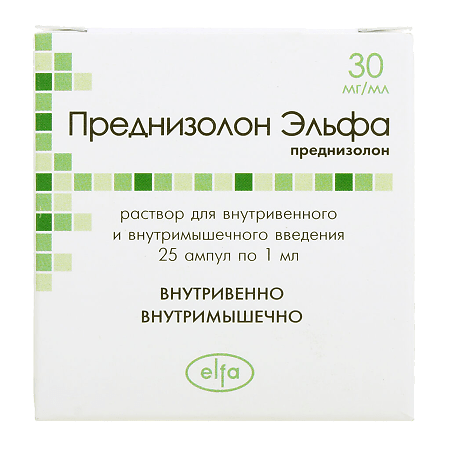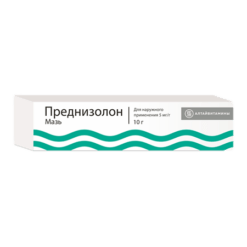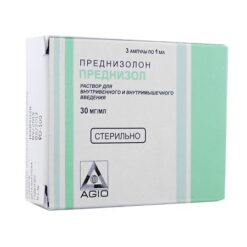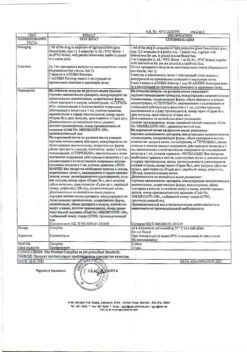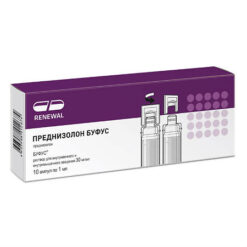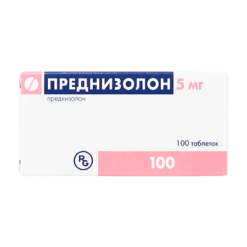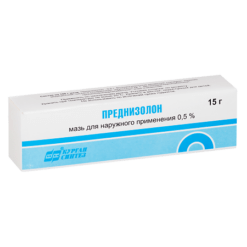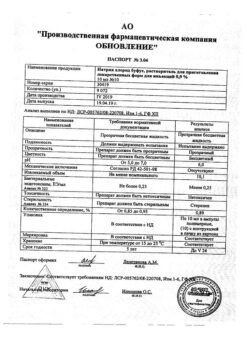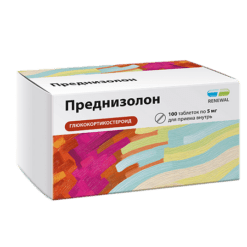No products in the cart.
Prednisolone Elfa, 30 mg/ml 1 ml 25 pcs
€1.00
Out of stock
(E-mail when Stock is available)
Description
Pharmacotherapeutic group: glucocorticosteroid
ATX code: H02AB06
Prednisolone is a synthetic glucocorticoid drug dehydrated analog of hydrocortisone. It has anti-inflammatory anti-allergic immunosuppressive effect increases the sensitivity of beta-adrenoreceptors to endogenous catecholamines.
It interacts with specific cytoplasmic receptors (there are receptors for glucocorticosteroids (GCS) in all tissues, especially in liver) with the formation of a complex which induces formation of proteins (including enzymes regulating vital processes in cells).
Protein metabolism: decreases the number of globulins in the plasma increases the synthesis of albumin in the liver and kidneys (with an increase of the ratio albumin/globulin) reduces synthesis and increases catabolism of protein in muscle tissue.
Lipid metabolism: increases the synthesis of higher fatty acids and triglycerides redistributes fat (fat accumulation occurs mainly in the shoulder girdle of the face of the abdomen) leads to hypercholesterolemia.
Carbohydrate metabolism: Increases absorption of carbohydrates from the gastrointestinal tract; increases glucose-6-phosphatase activity (increased glucose entry from the liver into the blood); increases phosphoenolpyruvate carboxylase activity and aminotransferase synthesis (activation of gluconeogenesis); promotes hyperglycemia.
Water-electrolyte metabolism: Retains Na+ and water in body stimulates K+ excretion (mineralocorticoid activity) reduces Ca2+ absorption from gastrointestinal tract reduces bone mineralization.
Anti-inflammatory effect is associated with inhibition of release of inflammatory mediators by eosinophils and mast cells; induction of formation of lipocortins and reduction of the number of mast cells producing hyaluronic acid; reduction of capillary permeability; stabilization of cell membranes (especially lysosomal) and organelle membranes. Acts on all stages of the inflammatory process: inhibits the synthesis of prostaglandins at the level of arachidonic acid (lipokortin inhibits phospholipase A2 and inhibits the liberation of arachidonic acid and biosynthesis of endoperoxy leukotrienes contributing to inflammatory processes of allergy, etc.) the synthesis of “anti-inflammatory” and “anti-pain”.) synthesis of “pro-inflammatory cytokines” (interleukin-1 tumor necrosis factor alpha, etc.) and increases the resistance of the cell membrane to the action of various damaging factors.
Immunosuppressive effect is caused by inhibition of lymphocyte proliferation (especially T-lymphocytes) caused by involution of lymphoid tissue, suppression of B-cell migration and interaction between T- and B-lymphocytes inhibition of cytokine release (interleukin-1 2 interferon gamma) from lymphocytes and macrophages and reduction of antibody formation.
Anti-allergic effect develops as a result of reducing the synthesis and secretion of allergy mediators inhibition of the release from sensitized mast cells and basophils of histamine and others. biologically active substances decrease in the number of circulating basophils suppression of lymphoid and connective tissue development decrease in the number of T- and B-lymphocytes of mast cells decrease in sensitivity of effector cells to allergy mediators suppression of antibody formation change the immune response of the body.
In obstructive airways diseases the action is mainly caused by inhibition of inflammatory processes and decrease of mucous membranes edema intensity decrease of eosinophilic infiltration of submucous layer of bronchial epithelium and deposition of circulating immune complexes in bronchial mucosa as well as inhibition of erosion and mucosa desquamation. It increases sensitivity of beta-adrenoreceptors of small and medium caliber bronchi to endogenous catecholamines and exogenous sympathomimetics reduces mucus viscosity by reducing its production.
Suppresses the synthesis and secretion of ACTH and secondary to the synthesis of endogenous GCS.
Inhibits connective tissue reactions during the inflammatory process and reduces the possibility of scar tissue formation.
Pharmacokinetics:
Up to 90% of the drug is bound to plasma proteins: transcortin (cortisol-binding globulin) and albumin. Prednisolone is metabolized in the liver partially in the kidneys and other tissues mainly by conjugation with glucuronic and sulfuric acids. Metabolites are inactive. It is excreted with the bile and urine by glomerular filtration and is 80-90% reabsorbed by the tubules. 20% of the dose is excreted unchanged by the kidneys. The plasma elimination half-life after intravenous administration is 2-3 hours.
Indications
Indications
Prednisolone is used for emergency therapy in conditions requiring rapid increase in the concentration of glucocorticosteroids in the body:
– shock conditions (burn traumatic traumatic operative toxic cardiogenic) – when vasoconstrictors of plasma substitute drugs and other symptomatic therapy are ineffective;
– allergic reactions (acute severe forms) hemotransfusion shock anaphylactic shock anaphylactoid reactions;
– brain edema (including.Ñ.
– brain edema (including against the background of a brain tumor or associated with surgery, radiation therapy or head trauma);
– bronchial asthma (severe form) asthmatic status;
– systemic connective tissue diseases (systemic lupus erythematosus rheumatoid arthritis);
– acute adrenal insufficiency;
– thyrotoxic crisis;
– acute hepatitis hepatic coma;
– reduction of inflammation and prevention of scarring (in poisoning with cauterizing fluids).
Active ingredient
Active ingredient
Composition
Composition
1 ml contains:
active ingredient: prednisolone sodium phosphate (equivalent to prednisolone) 30 mg;
auxiliary substances: dinatrium hydrophosphate anhydrous, sodium dihydrophosphate dihydrate, dinatrium edetate, propylene glycol, water for injection.
How to take, the dosage
How to take, the dosage
The dose of the drug and duration of treatment is set by the doctor individually, depending on the indications and severity of the disease. Prednisolone is administered intravenously (by drip or stream) or intramuscularly. Intravenously, the drug is usually given first by trickle and then by drip.
In acute adrenal insufficiency a single dose of the drug is 100 to 200 mg daily 300 to 400 mg.
In severe allergic reactions Prednisolone is administered in a daily dose of 100-200 mg for 3-16 days.
In bronchial asthma the drug is administered depending on the severity of the disease and the effectiveness of the complex treatment of 75 to 675 mg for 3 to 16 days; in severe cases, the dose may be increased to 1400 mg per course of treatment or more with gradual reduction of the dose.
In asthmatic status Prednisolone is given at a dose of 500-1200 mg daily with subsequent reduction to 300 mg daily and transition to maintenance doses.
In thyrotoxic crisis administer 100 mg of the drug in a daily dose of 200-300 mg; if necessary, the daily dose may be increased to 1000 mg. The duration of administration depends on the therapeutic effect, usually up to 6 days.
In case of shock resistant to standard therapy Prednisolone is usually given by trickle at the beginning of therapy after which it is switched to drip infusion. If within 10-20 minutes the blood pressure does not rise, the drug is repeated by trickle administration. After recovery from shock continue drip administration until the blood pressure stabilizes. The single dose is 50-150 mg (in severe cases up to 400 mg). The drug shall be repeatedly administered after 3-4 hours. The daily dose may be 300-1200 mg (with subsequent dose reduction).
In acute hepatic and renal failure (in acute poisoning in postoperative and postpartum periods, etc.) Prednisolone is administered in 25-75 mg daily; if indicated, the daily dose may be increased to 300-1500 mg daily and higher.
In rheumatoid arthritis and systemic lupus erythematosus Prednisolone is administered in addition to systemic drug administration in a dose of 75-125 mg daily for not more than 7-10 days.
In acute hepatitis Prednisolone is administered at 75-100 mg daily for 7-10 days.
Prednisolone is administered in a dose of 75-400 mg per day for 3-18 days in cauterized fluid poisoning with burns of the digestive tract and upper respiratory tract.
If intravenous administration is not possible, Prednisolone is administered intramuscularly in the same doses. After the acute condition is relieved, oral Prednisolone tablets are prescribed with subsequent gradual reduction of the dose. When taking the drug for a long time the daily dose should be reduced gradually. Long therapy should not be stopped suddenly!
Interaction
Interaction
Prednisolone may be pharmaceutically incompatible with other intravenous drugs – it is recommended to administer it separately from other drugs (by IV bolus or through another dropper as a second solution). When mixing prednisolone solution with heparin, a precipitate is formed.
Simultaneous administration of prednisolone with:
– inducers of “hepatic” microsomal enzymes (phenobarbital rifampicin phenytoin theophylline ephedrine) leads to a decrease in its concentration;
– diuretics (especially “thiazide” and carboanhydrase inhibitors) and amphotericin B – can lead to increased excretion of K+ and an increased risk of heart failure;
– with sodium-containing drugs – development of edema and increased arterial pressure;
– with cardiac glycosides – worsens their tolerance and increases the risk of ventricular extrasystole (due to hypokalemia caused);
– indirect anticoagulants – weakens (less often increases) their effect (requires dose adjustment);
– anticoagulants and thrombolytics – increases the risk of bleeding from gastrointestinal ulcers;
– Ethanol and nonsteroidal anti-inflammatory drugs (NSAIDs) – the risk of gastrointestinal erosive ulcers and bleeding increases (in combination with NSAIDs in the treatment of arthritis, the dose of glucocorticosteroids may decrease due to the summation of therapeutic effect);
Paracetamol – there is an increased risk of hepatotoxicity (induction of liver enzymes and formation of the toxic metabolite of paracetamol);
– Acetylsalicylic acid – accelerates its elimination and reduces its concentration in the blood (on cancellation of prednisolone, salicylate blood levels increase and the risk of side effects increases);
Insulin and oral hypoglycemic hypotensive agents – their effectiveness decreases;
– Vitamin D – its effect on Ca2+ absorption in the gut is reduced;
– somatotropic hormone – reduces the effectiveness of the latter and with praziquantel – its concentration;
– M-cholinoblockers (including antihistamines and tricyclic antidepressants) and nitrates – increases intraocular pressure;
Isoniazid and mexiletine – increases their metabolism (especially in “slow” acetylators) which leads to a decrease in their plasma concentrations.
Carboanhydrase inhibitors and “loop” diuretics may increase the risk of osteoporosis.
Indomethacin displaces prednisolone from binding to albumin and increases the risk of its side effects.
ACTH increases the effects of prednisolone.
Ergocalciferol and parathormone prevent the development of osteopathy caused by prednisolone.
Cyclosporine and ketoconazole, by slowing the metabolism of prednisolone, may in some cases increase its toxicity.
The concomitant administration of androgens and steroidal anabolic drugs with prednisolone promotes peripheral edema and hirsutism and the appearance of acne.
Estrogens and oral estrogen-containing contraceptives decrease clearance of prednisolone and may increase its effects.
Mitotan and other inhibitors of adrenal cortex function may necessitate increasing the dose of prednisolone.
The concomitant use with live antiviral vaccines and with other types of immunizations increases the risk of virus activation and infections.
Antipsychotics (neuroleptics) and azathioprine increase the risk of cataracts when prescribed with prednisolone.
Concomitant use with antithyroid drugs decreases and with thyroid hormones increases clearance of prednisolone.
Special Instructions
Special Instructions
During treatment with Prednisolone (especially long-term), monitoring of blood pressure, water-electrolyte balance, peripheral blood count, and blood glucose levels should be performed by an ophthalmologist.
In order to decrease side effects, antacids can be prescribed, and the intake of K+ in the body can be increased (dietary potassium preparations). Food should be rich in proteins, vitamins, and low in fat, carbohydrates, and table salt.
The action of the drug is increased in patients with hypothyroidism and cirrhosis. The drug may aggravate existing emotional instability or psychotic disorders. If a history of psychosis is indicated, Prednisolone in high doses is prescribed under strict medical supervision.
Prednisolone should be used with caution in acute and subacute myocardial infarction – the foci of necrosis may spread, delay formation of scar tissue and rupture of the heart muscle.
In stressful situations during maintenance treatment (e.g., surgical trauma or infectious diseases), the drug dose should be adjusted due to increased need for glucocorticosteroids.
If withdrawal is started suddenly, especially if high doses were previously used, withdrawal may occur (anorexia, nausea, lethargy, generalized musculoskeletal pain, generalized weakness) and worsening of the condition for which Prednisolone was prescribed.
Prednisolone should not be administered during treatment with Prednisolone due to decreased efficacy (immune response).
When Prednisolone is prescribed for intercurrent infections with septic conditions and tuberculosis, treatment with antibiotics with bactericidal action must be carried out at the same time.
In children during prolonged treatment with Prednisolone the growth and development dynamics should be closely monitored. Children who have been in contact with patients with measles or chickenpox during treatment are given specific immunoglobulins prophylactically.
Because of the weak mineralocorticoid effect for substitution therapy in adrenal insufficiency Prednisolone is used in combination with mineralocorticoids.
In diabetic patients, blood glucose levels should be monitored and therapy should be adjusted if necessary.
The radiological monitoring of the bone and joint system (spinal pictures of the hand) is indicated.
Prednisolone in patients with latent renal tract infections may cause leukocyturia, which may be of diagnostic value.
Prednisolone increases metabolites of 11- and 17- oxytocorticosteroids.
Contraindications
Contraindications
The only contraindication for short-term use for vital indications is hypersensitivity to prednisolone or components of the drug.
In children during growth, GCS should be used only for absolute indications and under the special close supervision of the attending physician.
With caution:
The drug should be prescribed with caution for the following diseases and conditions:
– Gastrointestinal diseases – gastric and duodenal ulcer esophagitis gastritis acute or latent peptic ulcer recently created intestinal anastomosis nonspecific ulcerative colitis with a risk of perforation or abscessing diverticulitis.
– Parasitic and infectious diseases of viral fungal or bacterial nature (current or recent including recent exposure) – herpes simplex herpes zoster (viremic phase) chickenpox measles; amebiasis strongyloidiasis; systemic mycosis; active and latent tuberculosis. Application in severe infectious diseases is allowed only against the background of specific therapy.
– Pre- and postvaccination period (8 weeks before and 2 weeks after vaccination) lymphadenitis after BCG vaccination.
– Immunodeficiency conditions (including AIDS or HIV infection).
– Diseases of the cardiovascular system (including recent myocardial infarction – patients with acute and subacute myocardial infarction may spread the focus of necrosis slow formation of scar tissue and thus a rupture of the heart muscle) severe chronic heart failure arterial hypertension hyperlipidemia).
– Endocrine disorders – diabetes mellitus (including impaired tolerance to carbohydrates) thyrotoxicosis hypothyroidism Icenko-Cushing’s disease obesity (III-IV stage).
– Severe chronic renal and/or hepatic failure nephrolithiasis.
– Hypoalbuminemia and conditions predisposing to its occurrence.
– Systemic osteoporosis myasthenia gravis acute psychosis poliomyelitis (except for forms of bulbar encephalitis) open and closed angle glaucoma.
Pregnancy.
Side effects
Side effects
The frequency and severity of side effects depend on the duration of use, the dose used, and the ability to maintain the circadian rhythm of Prednisolone administration.
When using Prednisolone, side effects may occur:
From the endocrine system: decreased glucose tolerance steroid diabetes mellitus or manifestation of latent diabetes mellitus suppression of adrenal function Icenko-Cushing’s syndrome (moon-shaped face hypophysial obesity hirsutism increased blood pressure dysmenorrhea amenorrhea muscle weakness streak) delayed sexual development in children.
In the digestive system: nausea vomiting pancreatitis steroid gastric and duodenal ulcer erosive esophagitis gastrointestinal bleeding and perforation of the wall of the gastrointestinal tract increase or decrease appetite digestive disorders flatulence hiccups. In rare cases – increased activity of “liver” transaminases and alkaline phosphatase.
Cardiovascular system disorders: arrhythmia bradycardia (up to cardiac arrest); development (in predisposed patients) or increase of severity of heart failure changes on electrocardiogram characteristic of hypokalemia increase of blood pressure hypercoagulation thrombosis. In patients with acute and subacute myocardial infarction – expansion of the focus of necrosis, slowing the formation of scar tissue, which may lead to rupture of the heart muscle.
Nervous system disorders: delirium disorientation euphoria hallucinations manic-depressive psychosis depression paranoia increased intracranial pressure nervousness or anxiety insomnia dizziness vertigo vertigo pseudotumor cerebellar headache seizures.
Sense organs: posterior subcapsular cataract increased intraocular pressure with possible damage to the optic nerve tendency to develop secondary bacterial fungal or viral eye infections trophic changes of the cornea exophthalmus sudden loss of vision (when parenteral administration in the scalp scalp neck nasal cavities possible deposition of drug crystals in the blood vessels of the eye)
Sensory organs
Metabolic side: increased calcium excretion hypocalcemia increased body weight negative nitrogen balance (increased protein breakdown) increased sweating.
Mineralocorticoid-induced fluid and sodium retention (peripheral edema) hypernatremia hypokalemic syndrome (hypokalemia arrhythmia myalgia or muscle spasm unusual weakness and fatigue.)
Musculoskeletal side: growth retardation and ossification processes in children (premature closure of epiphyseal growth zones) osteoporosis (very rare – pathological bone fractures aseptic necrosis of the head of the humerus and femur) rupture of muscle tendons steroid myopathy reduction of muscle mass (atrophy).
Skin and mucous membranes: delayed wound healing petechiae ecchymosis thinning of the skin hyper- or hypopigmentation steroid acne struria susceptibility to pyoderma and candidiasis.
Allergic reactions:cutaneous rash itching anaphylactic shock local allergic reactions.
Local reactions when parenteral administration: burning numbness pain tingling at the injection site infection at the injection site rarely – necrosis of the surrounding tissue formation of scars at the injection site; skin and subcutaneous tissue atrophy when injected in/m (especially dangerous injection in the deltoid muscle).
Others: development or exacerbation of infections (the appearance of this side effect is promoted by co-administration of immunosuppressants and vaccination) leukocyturia “withdrawal” syndrome.
Overdose
Overdose
Pregnancy use
Pregnancy use
In pregnancy (especially in the first trimester), use only for vital signs.
Because glucocorticosteroids penetrate into the breast milk, if it is necessary to use the drug during breastfeeding, it is recommended to stop breastfeeding.
Similarities
Similarities
Additional information
| Shelf life | 3 years. Do not use after the expiration date stated on the package. |
|---|---|
| Conditions of storage | Keep out of the sight and reach of children at a temperature not exceeding 25°C. Do not freeze. |
| Manufacturer | Indus Pharma Pvt.Ltd, India |
| Medication form | solution |
| Brand | Indus Pharma Pvt.Ltd |
Other forms…
Related products
Buy Prednisolone Elfa, 30 mg/ml 1 ml 25 pcs with delivery to USA, UK, Europe and over 120 other countries.

